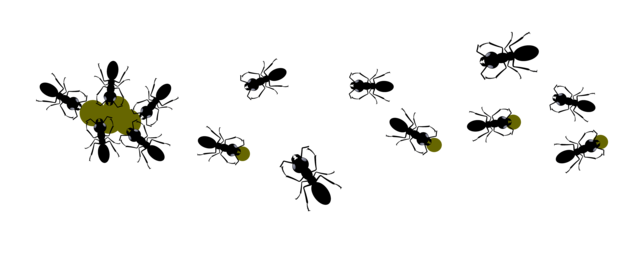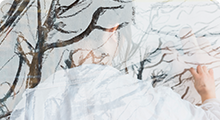Complex systems around us
Ant trails
How is it that ants are able to create trails without our being aware of it?
As the summer ends, we start to see the corpses of cicadas appearing at the side of the road and in gardens. Large numbers of ants converge on the cicadas, forming a trail that connects the cicada and the ant hill. Also, in the heat of the early afternoon, you may carelessly drop some ice cream as you sit eating it in the park. All of a sudden, ants appear from nowhere and gather around. Ants are carnivores, but also have a sweet tooth, and they have a habit of carrying both cicadas and ice cream back to their nests as food.
But how is it that ants are able to create these trails? First, it seems that ants understand the relationship between their own position and that of their nest. They look around for food in hit-or-miss fashion, and when they eventually find it, they pick it up, leave a “signpost” and return with the food to the nest. When another ant encounters the signpost, it searches for food in accordance with this, leaves another signpost, then carries the food back to the nest. These signposts gradually become more distinct, leading to large numbers of ants following the signposts to the location of the food and coming and going between that and the nest. This is how ant trails are created. (⇒ Reference “Ant trail model”)
In other words, it is not that ants intend to create trails, but the behavior of one single ant influences many other ants in due course, and the result is the formation of a trail. Here the mechanism resembles that by which birds create flocks. (⇒ Reference “Flocks of birds”)

When many ants gather around the signposts, does this cause traffic jams? In fact, when ants make a single line along the trail, it does create something like the traffic jams we encounter on single-lane roads. When there are too many ants, it does indeed cause a “traffic jam.” (⇒ Reference “Natural traffic congestion”)
Incidentally, the signposts left by ants are one of a class of substances called pheromones, which affect the behavior of their peers. These are called, literally, signpost pheromones. But how do ants who encounter the strip of pheromones know in which direction the food lies and in which direction the nest lies? If as mentioned above the ant understands the relationship between their own position and that of the nest, perhaps it is able to judge that the food is in the opposite direction to the nest. Ants belong to the same order as wasps, but wasps that fly through the air and ants that walk the earth differ significantly in the way they convey information about the location of food sources.



